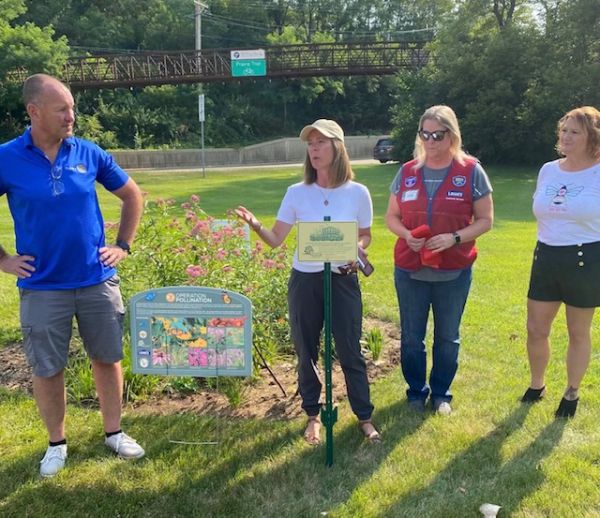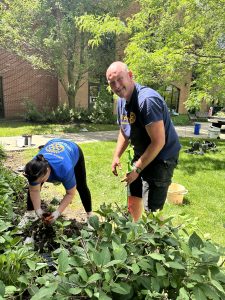
Conservation@Work Spotlight – Wade Merritt
 Saving pollinators became my focus after hearing Christopher Stein, the founder of Operation Pollination, speak at the Lake in the Hills Rotary Club in 2020.
Saving pollinators became my focus after hearing Christopher Stein, the founder of Operation Pollination, speak at the Lake in the Hills Rotary Club in 2020.
I did research on the drastic decline in pollinators and the causes of the decline. One thing struck me – I grew up on a farm in Kane County. We spent days spraying the milkweed that lined the fields to keep it from spreading. Little did I know the effect it would have on the environment. I wanted to do what I could to right this wrong, so I decided to plant as many milkweed (and other native plants) as possible.
With the help of the club, we were able to get our first land donation from VCP Printing in Algonquin, next to the bike path where it would be visible to many. It was a small plot, only an 11-foot circle, but even small plots can make a difference.
I found out that TLC would assess the area and recommend the best plants for the site. Sarah Michehl gave us a great list of plants through TLC’s Conservation@Work program. Soon we had many flowers that brought pollinators.
I also began my at-home pollinator journey. Previously, I thought you needed a pristine lawn that required fertilizer, pesticides and weed killers. I called on Sarah again to give a consultation through TLC’s Conservation@Home program.
My home has a large natural area with oaks, hickories, elms and maples. But I also had honeysuckle, garlic mustard and a burning bush that I didn’t know were invasive. Sarah gave me a list of native plants, and I started changing everything I had been doing. I added milkweed and butterfly weed for the monarchs and other natives to help the pollinators.
I converted old flower beds to pollinator gardens and removed grass and replaced it with native plants. Now my yard is full of many types of pollinators, including dozens of hummingbirds and monarchs in the summer. The remaining grass is now unfertilized, with no pesticides or weed killers.
With the help of Sarah and TLC’s Conservation@Work program, I have now planned and planted three more public gardens. One in Sunset Park in Lake in the Hills, another at a retirement village, and the most recent at the Algonquin Public Library.
Because I wanted to learn more about the monarchs, I took two trips to their sanctuaries. One was Piedra Herrada in El Pedregal, Mexico and one at Pismo Beach, California. I learned that the monarchs are arriving much later in Mexico than in the past. Mexico celebrates the Day of the Dead on Nov. 1, and part of the celebration is the return of the monarchs, which they believe are the souls of those who have passed during the last year. Now the monarchs don’t return until mid-November. One of the reasons could be that industrialization has moved the path of the monarch and added an additional 10-15 miles to their flight. While in Mexico I helped with the reforestation of property near the sanctuary. We planted 400 new trees in an attempt to help the monarchs in their journey.
My passion to help the pollinators keeps growing, and I am committed to make a difference in our environment.
TLC is scheduling Conservation@Work site visits for November & December 2024. Learn more here, or contact [email protected] for more information.